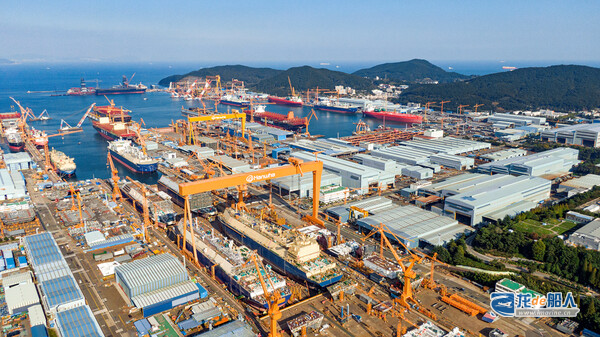In order to diversify its order structure, which is currently dominated by liquefied natural gas (LNG) carriers, Hanwha Ocean is accelerating its expansion into the markets for eco-friendly vessels, polar vessels, and special-purpose vessels. Against the backdrop of a slowdown in global orders and increasingly stringent environmental regulations, diversifying its business has become an inevitable choice.

According to Korean media, as of the end of June this year, Hanwha Ocean’s backlog of orders was worth about 40 trillion won (about US$ 28.72 billion), most of which were LNG carriers. As of the end of the first quarter of this year, Hanwha Ocean’s backlog of orders for LNG carriers reached 69, worth about US$ 16.54 billion, accounting for 70% of the total commercial vessel orders.
Based on overall orders, including special vessels, orders for Hanwha Ocean LNG carriers also account for more than 60%. Although LNG carriers are considered a stable source of profit, an overly concentrated order structure also poses a risk.
The problem is that LNG carrier orders have slowed down due to recent geopolitical uncertainties and increased protectionism. In the first half of this year, Hanwha Ocean only signed two new LNG carriers.
U.S. tariff policies and a decline in global freight volumes have impacted shipowners’ shipbuilding plans, leading to a slowdown in LNG carrier orders and raising concerns about a contraction in the overall shipbuilding cycle.
To this end, Hanwha Ocean is accelerating its expansion into the markets for environmentally friendly vessels and polar and special-purpose vessels. With the International Maritime Organization (IMO) tightening environmental regulations, demand for low-emission fuel vessels is expected to increase gradually.
Hanwha Ocean has already obtained certification for its ammonia fuel tank design and is preparing to develop methanol-related technologies. In response to the growing demand for offshore wind power facilities, Hanwha Ocean has also obtained approval from the American Bureau of Shipping (ABS) for a semi-submersible design. This means that Hanwha Ocean is actively diversifying its technology portfolio to focus on the environmentally friendly fuel transition and offshore engineering markets.
In addition, the polar and special vessel markets are also in Hanwha Ocean’s plans. In early July, the company was selected as the preferred bidder for South Korea’s next-generation icebreaker research vessel construction project, which is worth 250 billion won (about about US$ 180 million). It is planned to sign a formal contract within July and then enter the design phase. It is expected to be completed and delivered in December 2029.
Hanwha Ocean started developing polar vessels in 2008 and has accumulated rich technical strength. It has undertaken and built 21 icebreaking LNG carriers, including 15 in 2014 and 6 in 2020. In view of this, the company aims to seize the polar and icebreaker market.
Nevertheless, Hanwha Ocean’s market development path has not been easy. Chinese shipyards have rapidly risen to prominence and become highly competitive, with Chinese shipyards securing more than 50% of new building orders globally.
At the same time, although Hanwha Ocean has advantages in ship design and quality, the shortage of skilled workers and rising labor costs have increased the pressure on the unit price of cooperative enterprises, and the risk of delays in construction still exists. Although Hanwha Ocean is expanding its investment in automation equipment and robots in its shipyards, the industry believes that these problems will be difficult to solve in the short term.


